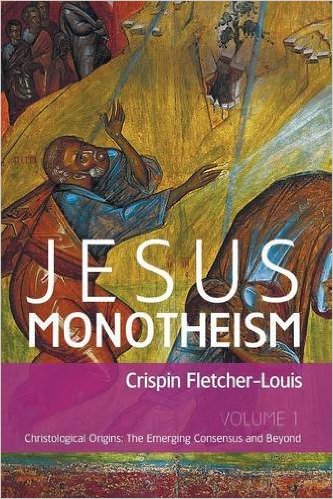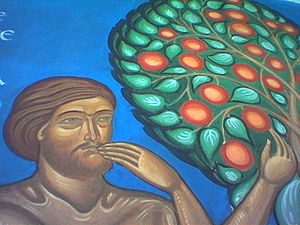 The Judaism prior to the destruction of the temple in 70 CE and that was the Judaism known to those responsible for the birth of Christianity was not the rabbinic Judaism that emerged in ensuing centuries. In recent years scholars Hurtado and Bauckham have attempted to defend the historical roots of contemporary Christian orthodoxy in relation to monotheism by focusing on evidence that suggests Second Temple Judaism (i.e. the Judaism prior to 70 CE) did not know of cultic worship of any figure other than The One God. Other scholars have criticized Hurtado and Bauckham for being too restricted in their selection of the evidence and for being too pedantically narrow in their question framing. One of these critics, and the latest one whose work has been added to my “to read” shelf, is Crispin Fletcher-Jones. His 2015 work is Jesus Monotheism: Volume 1. Christological Origins: the Emerging Consensus and Beyond.
The Judaism prior to the destruction of the temple in 70 CE and that was the Judaism known to those responsible for the birth of Christianity was not the rabbinic Judaism that emerged in ensuing centuries. In recent years scholars Hurtado and Bauckham have attempted to defend the historical roots of contemporary Christian orthodoxy in relation to monotheism by focusing on evidence that suggests Second Temple Judaism (i.e. the Judaism prior to 70 CE) did not know of cultic worship of any figure other than The One God. Other scholars have criticized Hurtado and Bauckham for being too restricted in their selection of the evidence and for being too pedantically narrow in their question framing. One of these critics, and the latest one whose work has been added to my “to read” shelf, is Crispin Fletcher-Jones. His 2015 work is Jesus Monotheism: Volume 1. Christological Origins: the Emerging Consensus and Beyond.
While it is too early for me to outline his arguments in this post, both those contrary to Bauckham’s and Hurtado’s theses and his own interpretations and broader implications for our understanding of Second Temple Judaism, I can at least for now quote the critical section of a Latin manuscript of the Life of Adam and Eve. (I’ll save the reasons for dating this text to the pre-70 CE era and other discussions of the various language manuscript lines till later.)
What is fascinating in this text is the reason God commands all the angels to worship Adam at the time of his creation — that is, before his “Fall”. The text throws us the first time we read it if we have always assumed that the Jews had as strict and narrow a conception of monotheism as we do and as we believe they have had ever since Moses.
The account of the command to worship Adam (Fletcher-Louis points out this analogy) reads remarkably like the challenge presented to Daniel and his friends by Nebuchadnezzar:
King Nebuchadnezzar made an image of gold . . .
Then the herald loudly proclaimed, “Nations and peoples of every language, this is what you are commanded to do: As soon as you hear the sound of the horn, flute, zither, lyre, harp, pipe and all kinds of music, you must fall down and worship the image of gold that King Nebuchadnezzar has set up. Whoever does not fall down and worship will immediately be thrown into a blazing furnace.”
Therefore, as soon as they heard the sound of the horn, flute, zither, lyre, harp and all kinds of music, all the nations and peoples of every language fell down and worshiped the image of gold that King Nebuchadnezzar had set up.
. . .
Shadrach, Meshach and Abednego replied to him, “King Nebuchadnezzar . . . we want you to know, Your Majesty, that we will not serve your gods or worship the image of gold you have set up.” (Daniel 3, NIV)
Setting up an image and commanding worship at its feet is a no-no — we all know that’s the rule of the God of the Bible. But think a moment about the creation of Adam who was made “in the image and likeness” of God.
Then God said, “Let us make mankind in our image, in our likeness. . . “ (Gen 1:26)
Adam is the image made by God. God made him in “his” image and in “his” likeness. The angels were commanded to worship the image of God. Continue reading “When God Commanded the Worship of Adam”


